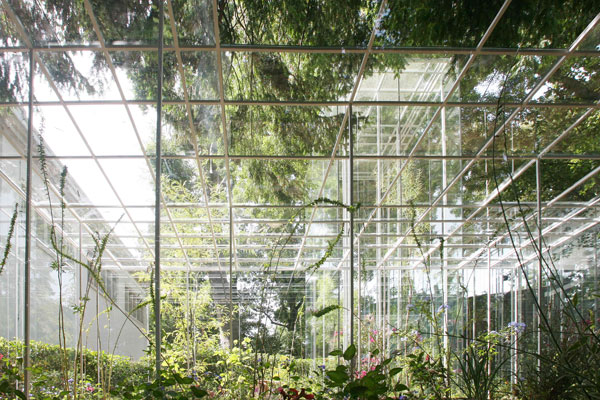If there is an emerging architect developing thinking truly like no other, it would be Junya Ishigami of Japan, writes Joanna Kawecki.

January 26th, 2015
Known for an explorative and conceptual approach to architecture, Japanese architect Junya Ishigami presents his global projects and ideas as unimaginable possibilities in a somewhat predictable industry and introduces a new sense of invisible realisations. His progressive and often highly imaginative ideas shape a philosophical yet pragmatic approach to space and structure, of considered dwellings, installations and furniture.

‘Extreme Nature’ for the 2008 Venice Biennale
Being initially intrigued and inspired by his own homes’ construction, it was in fact that first introduction to architecture that inspired him to enter the field and discipline. Born in Kanagawa Prefecture in 1974, Ishigami graduated with an MFA in Architecture from the Tokyo National University. Since working under Japanese architectural heavyweights SANAA (Ryue Nishizawa and Kazuyo Sejima), Ishigami opened his own Tokyo based practice, Junya Ishigami + Associates in 2004.
Re-composing space and traditional thinking, it is no understatement when he explains, “I challenge [myself] to go beyond the existing agenda of architecture.” His works include ‘Architecture as Air’ (a single 0.9mm curved line of columns floating in air), and ‘Table’, which is so thin, it wobbles.
As winner of the prestigious Golden Lion award at the 2010 Venice Architecture Biennale, his work is being recognised not only through those realised, or his plethora of books published, but his 58 built and unbuilt projects, most recently exhibited and showcased in Antwerp in 2013. In 2015, his global projects see an artwork commission in Sydney, Australia preparing the introduction of the city’s new public transport system. ‘Cloud Arch’, a sculpture-like piece made of painted steel and curved taper plates will be erected in the city’s centre and skyline.
With an open and reflective mindset, he welcomes new approaches and insists, “I’ve never had a project without the biggest challenge so far.”
We find out more.
What drives your interest to explore architecture and space?
A curiosity to see something that has not existed yet.
How important is imagination?
The imagination comes from outside – planning condition, site condition, local cultures and more – not from inside. I believe that the creative answer occurs by getting rid of stereotypes and genuinely facing the challenge in front of me with a fully fresh mind.

Port of Kinmen Passenger Service Centre
Cultural understanding varies from country to country. Do you find certain works are particularly more understood in different countries?
I do not think that [a piece of] architecture has to drive [toward the] same understanding. I see a value in diverse interpretations.
Why do you choose to express your ideas and projects in the form of print?
I cherish the old custom of the architecture field, and I believe there are new big potentials in it. I feel a great meaning in the fact that so many printed documents about architecture have been generated throughout its long history. I am interested in exploring new potentials of architecture in this mature framework of old relationships in the present day.
Do you feel you need to be a trained architect to realise a space?
I see potentials both in ‘architecture without architects’ and in the architecture by trained architects. I find precious meanings both in the architecture that naturally happens and the one driven by deep thoughts and theories.
What projects are you currently working?
I am currently working on projects all over the world including the Netherlands, Denmark, Russia, Taiwan, Australia, Chile, France and Japan. In all of these projects, I challenge [myself] to go beyond the existing agenda of architecture. I am hoping that we will see new worlds in front of our eyes when these projects are realised.
Photos courtesy of Junya Ishigami + Associates
Junya Ishigami
jnyi.jp
INDESIGN is on instagram
Follow @indesignlive
A searchable and comprehensive guide for specifying leading products and their suppliers
Keep up to date with the latest and greatest from our industry BFF's!

Schneider Electric’s new range are making bulky outlets a thing of the past with the new UNICA X collection.

Within the intimate confines of compact living, where space is at a premium, efficiency is critical and dining out often trumps home cooking, Gaggenau’s 400 Series Culinary Drawer proves that limited space can, in fact, unlock unlimited culinary possibilities.

To honour Chef James Won’s appointment as Gaggenau’s first Malaysian Culinary Partner, we asked the gastronomic luminaire about parallels between Gaggenau’s ethos and his own practice, his multidimensional vision of Modern Malaysian – and how his early experiences of KFC’s accessible, bold flavours influenced his concept of fine dining.

At Zaishui Art Museum in Ritzhao, Shandong Province, the Japanese architect has recontextualised the connection between architecture, nature and water.

The Sherman Centre for Culture and Ideas (SCCI) is back this year with its vibrant ten-day festival, the SCCI Architecture Hub 2019. Tickets are going fast!
The internet never sleeps! Here's the stuff you might have missed

Designed by architects Populous and Tyrrell Studio, construction has begun on the NSW Government’s $309 million redevelopment of Penrith Stadium led by John Holland Group.

Chinese handbag design firm, Songmont, has seen ARCHSTUDIO transform a disused factory into a space of great engagement and joy.

Emerging from millennia of geological force, each exquisite slab tells a singular narrative etched by time and tectonic power. And this luxurious dwelling serves as a masterful recontextualisation of this enduring beauty, highlighting the extraordinary aesthetic and uncompromising strength as the ultimate expressions of residential grandeur.